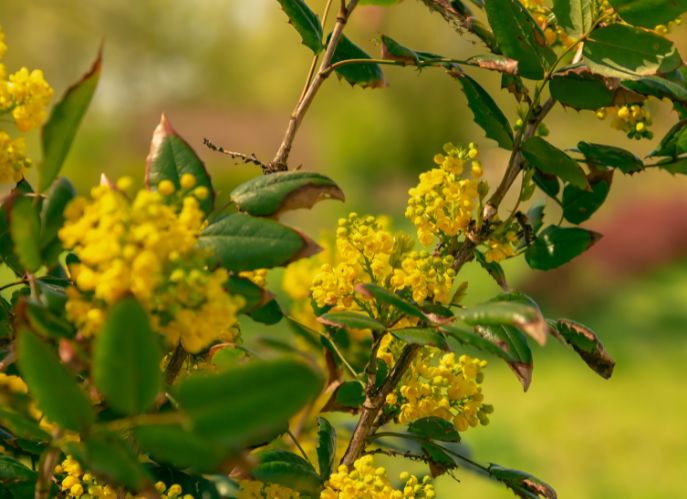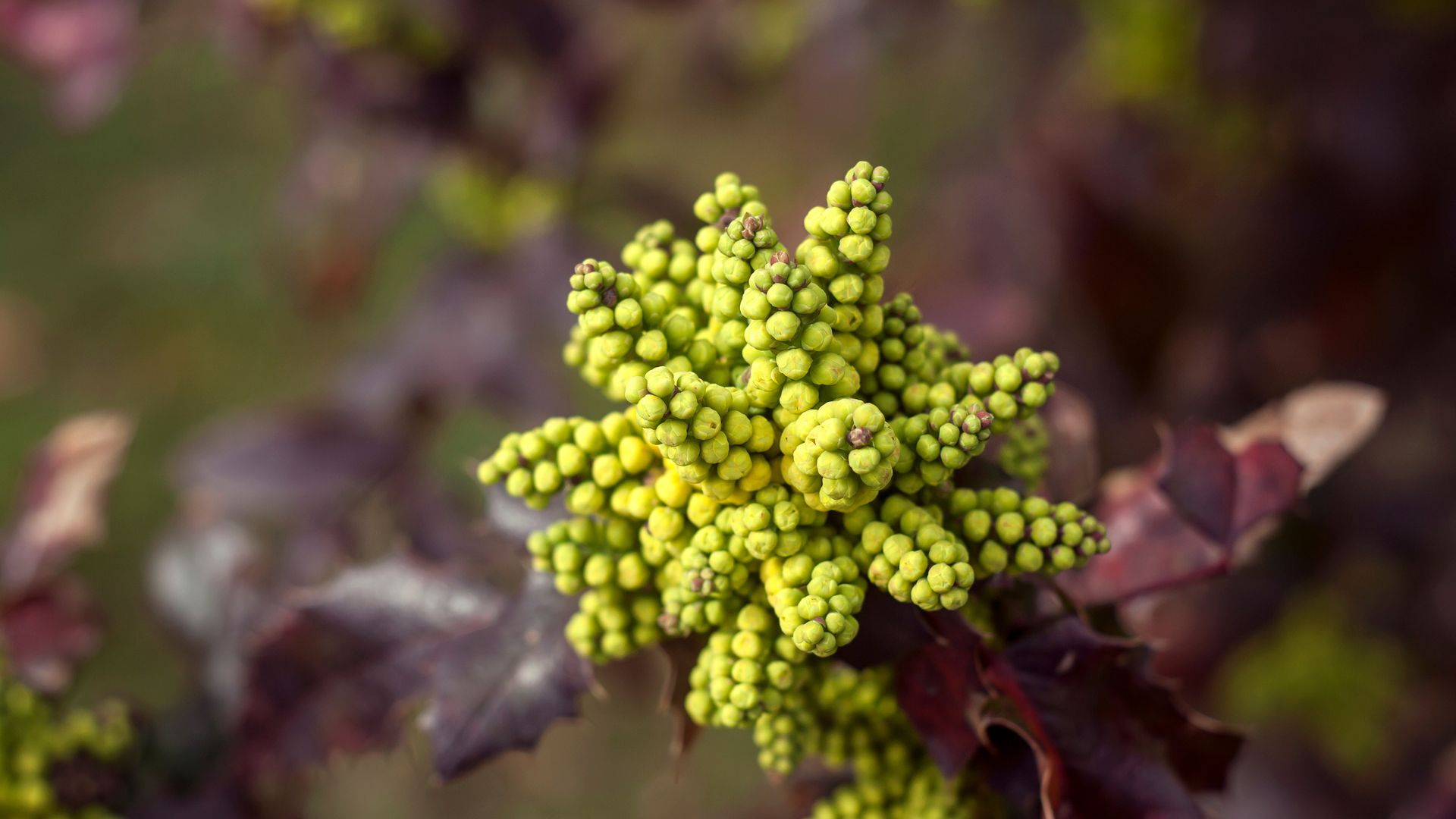What Is Oregon Grape?
The Oregon grape root, with its golden yellow roots and shiny holly-like leaves, is a fascinating herb that has captured the attention of herbalists and health enthusiasts alike. The Oregon grape (Berberis aquifolium or Mahonia aquifolium) belongs to the Berberidaceae plant family. Despite its name, the fruit it bears is not a grape. Native American tribes in the Pacific Northwest historically used Oregon grape for various ailments, including stomach issues, hemorrhages, tuberculosis, and arthritis. Today, it thrives not only in Oregon but also in other regions across the United States.
Historical Insights
- Native American Use: Long before European settlers arrived, Native American tribes across the Pacific Northwest were well acquainted with the Oregon grape. They utilized it for a myriad of purposes, including treating various ailments, dyeing baskets and garments with the yellow root, and consuming the tart berries.
- Official State Flower: Testament to its significance and widespread appreciation, the Oregon grape was designated the official state flower of Oregon in 1899. This accolade reflects not only the plant’s beauty but also its integral role in the state’s natural history.
- Medicinal Recognition: Oregon grape root entered the pharmacopeia of Western medicine in the late 19th century, primarily through the Eclectic medicine movement in the United States, which embraced plant-based remedies. Its use was advocated for treating liver disorders, digestive problems, and skin conditions, thanks to its antibacterial and anti-inflammatory properties.
Five Benefits of Oregon grape
- Liver Function Support: Oregon grape is believed to stimulate liver function, enhancing the liver’s ability to detoxify the blood and improve bile production. This can help with digestive problems and improve the elimination of toxins from the body, supporting overall health and well-being.
- Skin Health: Due to its antimicrobial and anti-inflammatory properties, Oregon grape is commonly used in the treatment of skin conditions, such as psoriasis, eczema, and acne. It can help reduce the severity of these conditions, leading to clearer and healthier skin.
- Blood Sugar Regulation: Berberine, one of the key compounds in Oregon grape, has been studied for its potential to help regulate blood sugar levels. It may improve insulin sensitivity and help manage symptoms of diabetes, making it a valuable supplement for blood sugar control.
- Diabetes and Elevated Blood Lipids: Experimental uses include treating diabetes, elevated blood lipids, and certain liver conditions.
- Stimulation of Bile Flow: The compounds in Oregon grape can stimulate bile production and secretion in the liver. Increased bile flow helps improve digestion and the absorption of fats and fat-soluble vitamins. It also aids in the elimination of waste products and toxins from the body, promoting overall digestive health.
Three Ways to Use Oregon grape
Topical Cream or Ointment
- How to Use: Oregon grape can be applied topically in the form of creams or ointments for skin conditions like psoriasis, eczema, or acne.
- Application: Apply a small amount of the cream or ointment to the affected area according to the product instructions or the advice of a healthcare provider.
Capsules or Tablets
- How to Use: Oregon grape root is available in capsule or tablet form, which is convenient for those who prefer not to taste the herb.
- Dosage: Follow the manufacturer’s instructions or the advice of a healthcare provider, as concentrations can vary.
Tea
- How to Prepare: You can make Oregon grape root tea by steeping about 1-2 teaspoons of dried root in boiling water for 10-15 minutes.
- How to Use: Drink the tea once it’s cooled down sufficiently, typically 1-3 times a day. Tea might be milder in effect compared to other forms.
Fascinating Facts

- Natural Antibiotic: One of the most compelling attributes of Oregon grape root is its berberine content. Berberine is a potent alkaloid that has been shown to have significant antimicrobial and anti-inflammatory effects, making it a natural antibiotic that’s effective against a wide range of bacteria, fungi, and protozoa.
- Versatile Culinary Uses: Although the plant is most celebrated for its medicinal properties, the berries of the Oregon grape are edible and have been used to make jellies, jams, and even wines. Their tart flavor can be a delightful addition to various recipes, reminiscent of currants or sour cherries.
- A Dyeing Agent: The vibrant yellow color of Oregon grape root comes from the presence of berberine. Historically, this pigment was used by Native Americans as a dye for clothing and basket materials, providing a rich, golden hue.
- Ecosystem Importance: Beyond its uses for humans, the Oregon grape plays a crucial role in its ecosystem. It provides food for local wildlife, including birds and mammals, which feast on its berries. Its dense foliage offers shelter and nesting sites, highlighting its value in biodiversity.
- Garden Favorite: Due to its ornamental beauty, Oregon grape has become a popular choice in gardens and landscaping projects, appreciated for its striking foliage, yellow flowers, and blue-black berries. It’s also valued for its drought resistance and as a low-maintenance addition to native plant gardens.
- Skin Care Ingredient: The anti-inflammatory and antimicrobial properties of Oregon grape root have made it a sought-after ingredient in skin care formulations, especially for treating conditions like psoriasis, acne, and eczema. Its efficacy in soothing skin irritation and reducing inflammation has been supported by various studies.
- Symbol of Resilience: The Oregon grape’s ability to thrive in diverse and sometimes challenging environments symbolizes resilience and adaptability. It can be found in a range of habitats, from coastal forests to rocky mountainsides, showcasing its hardiness.
Conclusion
Oregon grape root, belonging to the Berberidaceae family, is celebrated for its medicinal properties, particularly in the Pacific Northwest. Not an actual grape, it has been used historically for a variety of health issues, including stomach problems and arthritis. It offers benefits like enhancing liver function, improving skin health, regulating blood sugar levels, and stimulating bile flow, thanks to its key compound, berberine. Oregon grape can be utilized in several forms, including as a topical cream for skin conditions, in capsules or tablets for internal health, and as a tea. Each form serves different health purposes, making Oregon grape a versatile and valuable herbal remedy.



